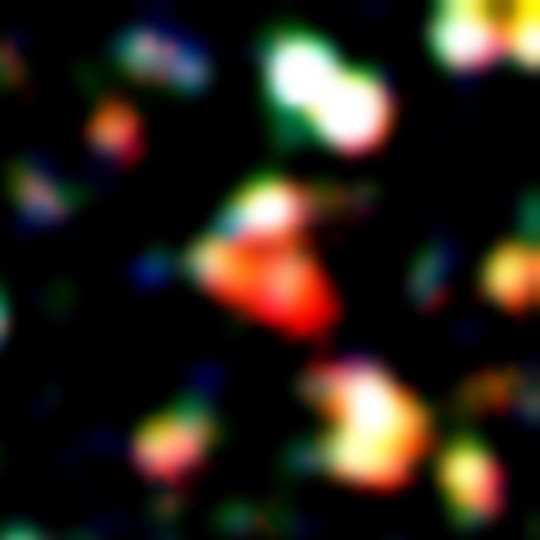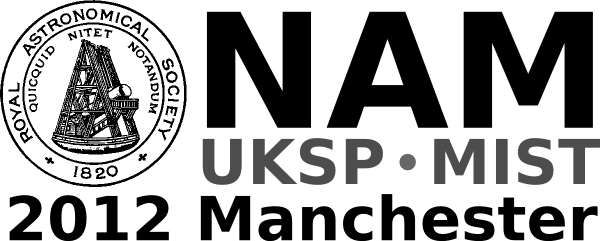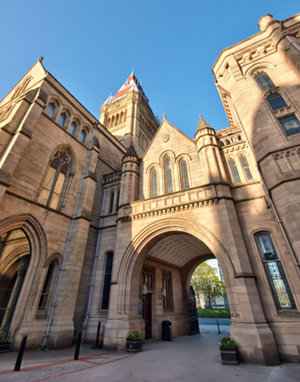UK-Germany National Astronomy Meeting NAM2012
GOODS-Herschel reveals gas mass role in creating fireworks versus beacons of star formation
Royal Astronomical Society press release
RAS PR 12/18 (NAM 9)
Tuesday 27 March 2012

False colour image from the Herschel Space Observatory of starburst galaxy GN20, 1.5 billion years after the Big Bang, or more than 12 billion years back into the history of the Universe. This is a "firework", with an extreme, but short-lived nevertheless, star-forming episode, believed to be triggered by a major merger. Credit: ESA/GOODS-Herschel Team and R. Gobat.
A study of galaxies in the deepest far-infrared image of the sky, obtained by the Herschel Space Observatory, highlights the two contrasting ways that stars formed in galaxies up to 12 billion years ago. Dr Georgios Magdis will present the results at the National Astronomy Meeting in Manchester.
Recent results from Herschel show that gas-rich galaxies in the early universe were able to create stars at an intense rate. In the nearby universe, we only see such high rates of star formation when galaxies collide. However, the Herschel data shows that while star-formation in some galaxies in the early universe were triggered by mergers, the majority of star forming galaxies were not undergoing interactions. The formation was driven by the amount of gas present.
Magdis and his colleagues have now carried out a detailed study of an example of a normal and a merging galaxy observed as part of the Great Observatories Origins Deep Survey (GOODS) Herschel programme. GOODS Herschel is led by David Elbaz of CEA/Saclay, France.
"The aim of this study was to estimate the amount of gas that the galaxies contained and understand how that affected the way that they formed stars. In contrast to what we see in the nearby universe, it was only in the minority of the intensively star forming galaxies that star formation activity was triggered by merging of galaxies," said Magdis, of the University of Oxford.
"The dominant population had very large gas reservoirs that could induce and maintain a high birth rate of stars without the need of galaxy ''cannibalism''. Such episodes of star-formation naturally resulted from steady, long lasting accretion of gas, forming these 'cosmic beacons' of our Universe. However, our study shows that the other population - merging galaxies - had ten times less gas, but the interactions made them much more efficient in converting gas into stars. These galaxies experienced an extreme but nevertheless short-lived firework of star formation, " said Magdis.
The team selected the galaxy BzK-21000, observed approximately 4 billion years after the Big Bang, as an example of the 'normal' gas-rich galaxy and GN20, a member of a rich proto-cluster of galaxies observed approximately 1.5 billion years after the Big Bang, as an example of an interacting galaxy. The mass of the gas in the galaxies cannot be measured directly as it mostly consists of hydrogen, which is difficult to detect. Instead the team measured levels of dust and carbon monoxide and, assuming that there are constant ratios with the mass of hydrogen present, used these to estimate the amount of gas present. The measurements were supplemented by radio detections from the Very Large Array (VLA) to constrain the uncertainties in the estimates for the mass of dust.
"This result comes to highlight the minor contribution of mergers in the history of star formation activity and point towards a more quite, smooth and 'independent' evolution of galaxies throughout the cosmic time," said Magdis.
IMAGES
False colour image of BzK-21000 from the Hubble Space Telescope, of 6 disk galaxies 4 billion years after the Big Bang (or more that 9 billion years back into the history of the Universe), now revealed to have large gas reservoirs, and a secular, quiescent, long lasting star formation mode driven by cold gas accretion. Credit, E. Daddi, http://www.ras.org.uk/images/stories/NAM/2012/3color_co.jpg
False colour image from the Herschel Space Observatory of starburst galaxy GN20, 1.5 billion years after the Big Bang, or more than 12 billion years back into the history of the Universe. This is a "firework", with an extreme, but short-lived nevertheless, star-forming episode, believed to be triggered by a major merger. Credit: ESA/GOODS-Herschel Team and R. Gobat, http://www.ras.org.uk/images/stories/NAM/2012/gn20.jpg
The paper behind the results discussed in the press release is Magdis et al. 2011, ApJ, 740, 15
The Astrophysical Journal Letters, Volume 740, Issue 1, article id. L15 (2011)
MEDIA CONTACTS
NAM 2012 Press Office (0900 - 1730 BST, 27-29 March; 0900 - 1630 BST 30 March)
Room 3.214
University Place building
University of Manchester
Manchester
UK
Tel: +44 (0)161 306 7313
Dr Robert Massey
Royal Astronomical Society
Mob: +44 (0)794 124 8035
Email: rm@ras.org.uk
Anita Heward
Royal Astronomical Society
Mob: +44 (0)7756 034 243
Email: anitaheward@btinternet.com
Dr Klaus Jaeger
Pressereferent / Press Officer im Vorstand der Astronomischen Gesellschaft
Tel: +49 6221 528 379
Email: pressereferent@astronomische-gesellschaft.de
Dan Cochlin
Media Officer (Faculty of Engineering and Physical Sciences)
University of Manchester
Tel: +44 (0)161 275 8387
Email: daniel.cochlin@manchester.ac.uk
SCIENCE CONTACTS
Dr Georgios Magdis
Department of Physics
University of Oxford
OX1 3RH
Tel: +44 (0)1865 273304
Email: georgios.magdis@astro.ox.ac.uk
NOTES FOR EDITORS
NAM 2012
Bringing together more than 900 astronomers and space scientists, the National Astronomy Meeting (NAM 2012) will take place from 27-30 March 2012 in the University Place conference centre at the University of Manchester in the UK. The conference is a joint meeting of the Royal Astronomical Society (RAS) and the German Astronomische Gesellschaft (AG) and is held in conjunction with the UK Solar Physics (UKSP: www.uksolphys.org) and Magnetosphere Ionosphere Solar Terrestrial (MIST: www.mist.ac.uk) meetings. NAM 2012 is principally sponsored by the RAS, AG, STFC and the University of Manchester.
The Royal Astronomical Society
The Royal Astronomical Society (RAS: www.ras.org.uk), founded in 1820, encourages and promotes the study of astronomy, solar-system science, geophysics and closely related branches of science. The RAS organises scientific meetings, publishes international research and review journals, recognizes outstanding achievements by the award of medals and prizes, maintains an extensive library, supports education through grants and outreach activities and represents UK astronomy nationally and internationally. Its more than 3500 members (Fellows), a third based overseas, include scientific researchers in universities, observatories and laboratories as well as historians of astronomy and others.
The Astronomische Gesellschaft (AG)
The Astronomische Gesellschaft (AG: www.astronomische-gesellschaft.de), founded in 1863, is a modern astronomical society with more than 800 members dedicated to the advancement of astronomy and astrophysics and the networking between astronomers. It represents German astronomers, organises scientific meetings, publishes journals, offers grants, recognises outstanding work through awards and places a high priority on the support of talented young scientists, public outreach and astronomy education in schools.
The Science and Technology Facilities Council
The Science and Technology Facilities Council (STFC: www.stfc.ac.uk) is keeping the UK at the forefront of international science and tackling some of the most significant challenges facing society such as meeting our future energy needs, monitoring and understanding climate change, and global security. The Council has a broad science portfolio and works with the academic and industrial communities to share its expertise in materials science, space and ground-based astronomy technologies, laser science, microelectronics, wafer scale manufacturing, particle and nuclear physics, alternative energy production, radio communications and radar. It enables UK researchers to access leading international science facilities for example in the area of astronomy, the European Southern Observatory.
Jodrell Bank Centre for Astrophysics
The Jodrell Bank Centre for Astrophysics (JBCA: www.jb.man.ac.uk) is part of the School of Physics & Astronomy at the University of Manchester. JBCA is split over two main sites: the Alan Turing Building in Manchester and the Jodrell Bank Observatory in Cheshire. At Jodrell Bank Observatory, the new Jodrell Bank Discovery Centre is a key focus for our work in public engagement and education. Jodrell Bank is a world leader in radio astronomy-related research and technology development with a research programme extending across much of modern astrophysics. The group operates the e-MERLIN national radio astronomy facility and the iconic Lovell Telescope, hosts the UK ALMA Regional Centre Node and is home to the international office of the SKA Organisation. Funded by the University, the Science & Technology Facilities Council and the European Commission, it is one of the UK's largest astrophysics research groups.





